A new business model that combines the latest technologies is already being used with tractors and is set to transform how assets are managed. The asset as a service business model could soon be coming to a tractor – or any other kind of industrial equipment – near you.

Tokenisation, blockchain and the internet of things may sound like futuristic technologies, but they are already transforming how assets are thought about – and managed. The asset-as-a-service business model is already being trialled, which means that machinery can become a profit centre, users pay per use, and investors have a new asset class.
“We make the world’s assets accessible and investable,” says Serkan Katilmis, CEO and Co-Founder of CashonLedger Technologies.
CashOnLedger has already implemented its solution for Lindner, an Austrian tractor manufacturer. The tractors have sensors on them, and – using telemetry and the internet of things – they send data back to CashOnLedger, which provides the middleware that connects this data to the payments, and the accounting software. With the sensors, it is possible to know when and how the machine is being used, thus creating an automated pay-per-use model for the asset.
This asset-as-a-service model is attractive to the users – for example, farmers using tractors – as they do not have to own the asset outright with a massive outlay. Instead, they pay each time they use it and depending on how they use it. “It is not a fixed rate – it is determined by the use of the asset. This is something new,” explains Katilmis.
And for equipment manufacturers, the billing and payment is automated, they get data on the asset for its entire life, and they have transparency on its cash flows and its ability to turn a profit. The lower upfront cost opens up new markets, to customers who previously wouldn’t have been able to afford to use their machines.
Also, the manufacturer is likely to receive income from the machine over a longer period of time. With leasing, Schmidt explains, the manufacturer would typically sell the asset after three to five years. “Pay per use has the potential to generate cash flows for the whole lifetime of the asset,” comments Lukas Schmidt, Senior Vice President at CashonLedger Technologies.
This model also contributes to the circular economy, he adds. If the manufacturer is receiving cash flows from the asset for longer, they will be motivated to maintain it better – making it more sustainable. This also makes it attractive to investors as the financial services industry becomes increasingly interested in environmental, social and governance (ESG) issues.
Schmidt explains that the solution is independent from the company’s enterprise resource planning (ERP) system. “We automate billing and accounting processes, compile the invoice and provide that to the manufacturer on a white label basis and integrate it into their ERP system after the invoicing has been done,” adds Schmidt.
Is blockchain – or distributed ledger technology (DLT) – necessary for this tractor-as-a-service business model? No, says Schmidt, who explains that the solution is cloud-native. DLT can be implemented on a larger scale when enough data and market participants are on the chain. “On a conceptual level, this is one of the best uses you can think of for blockchain,” he says. However, at the moment, DLT isn’t always used because not all manufacturers are able or interested in engaging with it.
The data from the tractors can be used to inform both debt and equity financing. And in theory, each individual tractor could ultimately be an investable asset, available to any kind of investor. The asset can be tokenised so that investors could be given ownership of a slice of it. These tokens – which would be put on a blockchain – could be traded, and the dividend payments automated by smart contracts.
There are different financing models that are possible, explains Schmidt. For example, the farmer – the user of the machine – could be provided with a pay per use loan so they can buy the tractor from the manufacturer. Or the bank could lend to the manufacturer so they still own the asset and run the pay-per-use arrangement.
Many options are possible, and the asset-as-a-service model has the potential to completely change how corporates think and manage their assets. These tractors are just the beginning.